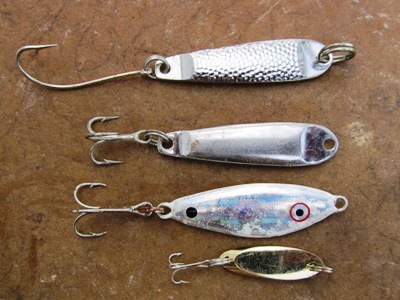Pier jigging can be extremely effective for catching saltwater fish. A variety of jigs work well on piers, including traditional ball-head jigs, bucktail jigs, speck rigs, metal jigs, gotcha plugs, sabiki rigs, and other lures. Anglers use jigs to catch striped bass, white perch, Spanish mackerel, spot, croakers, bluefish, flounder, hickory shad, and other species.
For pier-jigging to be productive, a number of factors must be present. Not only due the right species of fish need to be running, but also certain environmental conditions must exist around the pier. Time of day, tides, currents, weather conditions, and other factors can all affect pier fishing.
At several of Virginia’s top fishing piers, tidal cycles cause the water to reverse direction twice each day. These piers are subject to periods of slack water as well as varying current flows. These ever-changing currents can bring a variety of species into range of pier anglers.
When jigging from saltwater fishing piers, it is important to have a basic knowledge of local fish species and their behavior. Once the angler has chosen a target species of fish (or multiple species), lure selection can be considered.
Next, conditions at the pier should be assessed. Will wind be a factor when casting? Is the water clear or dirty? Is the current barely moving or running fast? What types of baitfish are present around the pier? What species of fish have been caught recently?
Once these observations have been made, lures can be selected for jigging. In some cases, a jig will be chosen to target a specific species, such as striped bass. In other cases, a single jig may work for a variety of species.
Metal slab jigs are among the most popular lures for pier fishing. They can be casted and retrieved or simply lowered and worked along pilings or other areas.
Lead head jigs are another good choice, either dressed with a bucktail skirt or fitted with soft plastic lure bodies. Lead head jigs are available in sizes from 1/32 oz. up to monster jigs of 10 oz. or more. The endless selection of models allow anglers to jig in any condition. Despite all the choices, a few simple designs remain popular.
Tandem rigs are another option for pier jigging. Tandem rigs can feature either two identical lures or two unlike lures. Identical tandem jigs are intended to appear as baitfish that have strayed from a school, while other pairs might appear as a small fish chasing its prey. Both types have specific applications for pier fishing.
Another popular lure is the gotcha plug. The gotcha plug features a simple but effective design that can be casted, trolled, or jigged in a moving current. Gotcha plugs are particularly useful for catching Spanish mackerel and bluefish.
One of the more specialized rigs for jigging is the Sabiki rig. This special leader features multiple small hooks that are dressed to look like tiny shrimp or baitfish. Some anglers add tiny morsels of bloodworm on each hook as an added attractant.
Sabiki rigs are usually jigged slowly near pilings. They can be highly effective for catching spot, perch, pinfish, and other small fish for use as live baits. Although they are useful, Sabiki rigs are prone to tangling and are difficult to store. Unless they are cleaned thoroughly after use, their tiny hooks will corrode and eventually break.
Jigs can be essential for catching hickory shad, a species that appears seasonally at several Virginia fishing piers. Hickory shad are caught using shad darts, or other small, flashy lures.
When strong currents make it impossible to fish with a single light-weight lure, anglers often rig shad jigs in pairs or daisy chains. Small jigs or flies can also be rigged on a dropshot rig for vertical jigging.
Each of these jigs and rigs are proven to work under specific conditions. By monitoring conditions on local piers, anglers can be ready to jig when the time is right.
